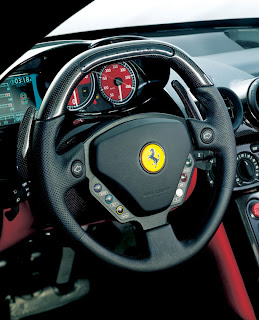The Lamborghini Murcielago is 2-seater, 2-door coupe (with the now familiar gull-wing doors) based on the traditional Lamborghini layout:
 mid-mounted V12 engine, typical Lamborghini transmission with the gearbox mounted in front of the engine and the rear differential integrated into the engine unit, permanent four-wheel drive with central viscous coupler.
mid-mounted V12 engine, typical Lamborghini transmission with the gearbox mounted in front of the engine and the rear differential integrated into the engine unit, permanent four-wheel drive with central viscous coupler.
This layout, successfully employed by Lamborghini for more than 30 years, affords an optimal weight distribution (42% front and 58% rear) with conspicuous advantages for traction, braking and handling.
The Murcielago chassis has been stiffened considerably to achieve a torsional rigidity value in excess of 20,000 Nm/°.
The suspension design (independent double wishbones) represents the best possible solution for a high-performance GT and, again, is in keeping with Lamborghini tradition.



2002 Lamborghini Murcielago Specifications
Make Lamborghini
Model 2002 Murcielago
Powertrain Layout Mid Engine / AWD
Base Price Not Available
Lamborghini Murcielago Dimensions
WheelBase 2665 mm / 104.9 in
Length 4580 mm / 180.3 in
Height 1135 mm / 44.7 in
Width 2045 mm / 80.5 in
Weight 1650 kg / 3638 lbs
Front / Rear Track F 1635 mm / 64.4 in
R 1695 mm / 66.7 in
Lamborghini Murcielago Engine
Configuration V12
Valvetrain DOHC, 4 valves / cylinder
Displacement 6192 cc / 377.9 cu in
Power 432.5 kw / 580.0 bhp @ 7500 rpm
Torque 650.0 nm / 479.4 ft lbs @ ???? rpm
Bore 87.0 mm / 3.43 in
Stroke 86.8 mm / 3.42 in
Compression Ratio Not Available
BHP / Liter 93.67 bhp
Redline Not Available
Lamborghini Murcielago Transmission
Type 6-Speed Manual
Final Drive Not Available
1st Gear Ratio 2.94:1
2nd Gear Ratio 2.06:1
3rd Gear Ratio 1.52:1
4th Gear Ratio 1.18:1
5th Gear Ratio 1.03:1
6th Gear Ratio 0.91:1
Lamborghini Murcielago Chassis & Body
Steering Rack & Pinion w/ Power Assist
Tire Sizes F 245/35ZR-18
R 335/30ZR-19
Brake Types Vented Discs w/ Power Assist
Brake Size F F 355 mm / 14.0 in
R R 335 mm / 13.2 in
Available ABS Not Available
Body Material Carbon Fibre
Lamborghini Murcielago Performance
Top Speed 205.1 mph / 330.0 kph
0 – 30 mph 2.1 secs
0 – 60 mph 3.7 secs
0 – 100 mph 6.1 secs
0 – ¼ mile Not Available


















































